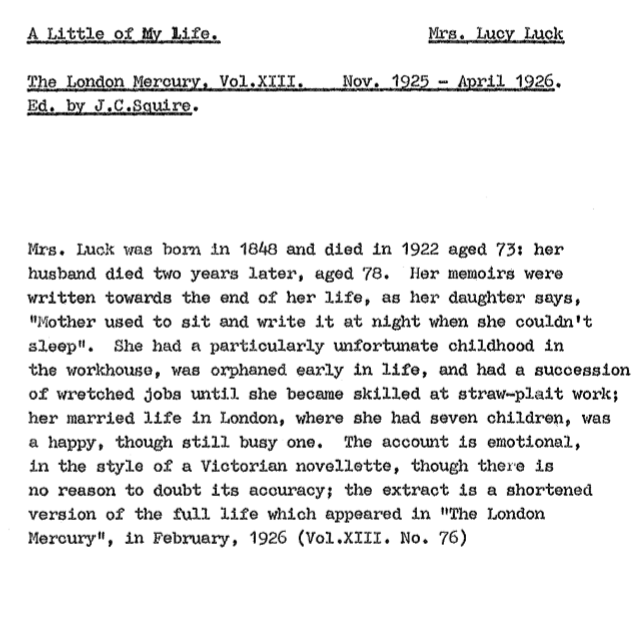Lucy Luck (1848-1922): An Introduction
“How often I was tempted to lead a bad life, but there always seemed to be a hand to hold me back.”
Published in The London Mercury in 1926, the autobiographical memoir Lucy Luck: A Little Of My Life follows the life of the hardworking author, born Lucy Marshall in 1848, whose early years were shaped by her father — a bricklayer and drunkard — abandoning his family when she was just four years old. The memoir relates the author’s life and struggles after entering the workhouse with her siblings and mother, to becoming a pauper apprentice in a silk mill, to learning the trade of straw plaiting, to marrying and bringing up a family in Paddington, all the while working at straw plaiting. Throughout the memoir Lucy does not shy away from writing about the struggles encountered by a working-class woman living through the Victorian era. Although the memoir deals with parts of life that are tragic and at times heart wrenching, Lucy’s narrative voice has a strong sense of faith and resilience that only strengthens the reader’s admiration for her unwavering fortitude.
The main aspect of Lucy’s life that is featured in the memoir is her working life and her time spent in service. Her memoir highlights the poor conditions of labour and demanding working hours with very little pay. Lucy’s description of her working life presents the goodness of people, with some opening their homes to Lucy when she has been left homeless. However, not everyone is so trustworthy. Lucy recalls in a particularly painful part of her memoir how one of her employers, “had taken all I possessed because I could not keep up with the amount of work she set me, just for my food (9).” There are often moments in the memoir when Lucy’s life takes a turn into situations that most would find impossible to navigate alone but her strong sense of self and determination always pull her through.
Whilst Lucy has many jobs throughout her life it is her career in straw plaiting that is detailed most within the memoir. Lucy goes into great detail when describing the straw plaiting industry and its dependence on seasonal work and prides herself on working for “forty-seven years and never missed one season (14).” The length of Lucy’s working life is one that is reflective of many Victorians and is a part of her memoir that shares a similar experience to other working-class writers of the time.
The copy of Lucy’s short memoir, only 15 pages, in the Burnett Archive of Working Class Autobiography, appears to be the pre-publication version, for it contains some corrections and deletions. However, we do not know who prepared the version for publication or how the newspaper acquired Lucy’s memoir. Neither do we know if Lucy wrote the autobiography herself or related her life-narrative to an interested party who wrote it down, perhaps with the intention of getting it into print. It was published in the London Mercury four years after Lucy’s death. The publication of her memoir is indicative of public interest in the recollections of ordinary people in the 1920s, and perhaps the appetite for accounts of triumph of adversity.
The memoir follows Lucy’s growth from her time as a poor workhouse child to a working mother, highlighting her progress through life. She is a person that the reader immediately has an affinity to as her narrative voice is both assertive and endearing and draws the reader in from the start of her memoir until the end.
Bibliography
Luck Lucy. A Little of My Life. London Mercury Newspaper. Vol. XIII. No 76. (1926)
Image of London Mercury Newspaper:
The London Mercury Newspaper. 29th April No.80 (1893)
Front Cover :
Lucy Luck. A Little of My Life. London Mercury Newspaper. Vol XII. No 76 (1926)



Leave a Reply